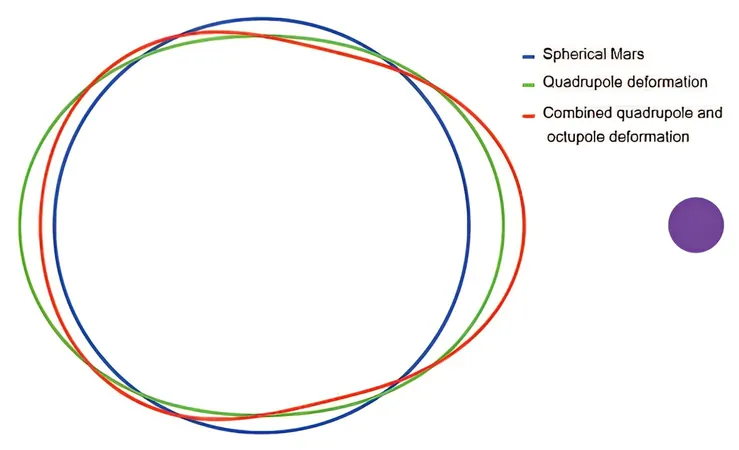
Is Mars's Unique Shape Linked to a Long-Lost Moon? New Hypothesis Surfaces!
2024-09-16
Author: Mei
Groundbreaking Hypothesis by Michael Efroimsky
A groundbreaking hypothesis proposed by astronomer Michael Efroimsky at the U.S. Naval Observatory may unravel the mystery behind the unusual shape and geological features of Mars. Published on the arXiv preprint server, his research suggests that a long-lost moon, which he terms 'Nerio,' could be the key to understanding Mars's distinct characteristics.
The Triaxial Shape of Mars
Unlike other planets in our solar system, Mars is noted for its triaxial shape—meaning it exhibits varying sizes along three different axes. This unique configuration coincides with some of the most remarkable geographical features known to us, including Olympus Mons, the tallest volcano and mountain in the solar system, and Valles Marineris, the largest canyon.
The Role of Tharsis Bulge
At the heart of the hypothesis is the Tharsis bulge, an enormous plateau that spans roughly 5,000 kilometers across and is located near the equator. Alongside the Tharsis bulge is another highland positioned directly opposite, which further adds to the planet's enigmatic structure.
Nerio's Gravitational Influence
Efroimsky theorizes that if the hypothetical moon, Nerio, were about one-third the size of our Moon, its gravitational influence could have significantly shaped Mars’s geological features during the formative years of the planet. This influence would have produced enough gravitational pull to draw surface material upward while Mars was still cooling and soft, eventually leading to the formation of the permanent bulge we see today.
Impact on Mars’s Structure and Activity
This bulge could have introduced equatorial ellipticity, contributing to Mars’s triaxial structure, and may have heightened volcanic activity on the planet, facilitating the formation of highlands on the opposite side of the Tharsis bulge.
The Fate of Nerio
As for the fate of the moon Nerio, Efroimsky speculates that it might have either drifted away due to gravitational interactions with other celestial bodies or met its end by colliding with another sizable object in space, resulting in the current Martian small moons, Phobos and Deimos, becoming the only remnants.
Need for Further Research
While the hypothesis is intriguing and presents a new perspective on the complexities of Mars, Efroimsky emphasizes that additional research and exploration are necessary to validate his theory. As we continue to unravel the mysteries of our neighboring planet, the question remains—could this lost moon unlock further secrets about the Red Planet’s past?
 Brasil (PT)
Brasil (PT)
 Canada (EN)
Canada (EN)
 Chile (ES)
Chile (ES)
 Česko (CS)
Česko (CS)
 대한민국 (KO)
대한민국 (KO)
 España (ES)
España (ES)
 France (FR)
France (FR)
 Hong Kong (EN)
Hong Kong (EN)
 Italia (IT)
Italia (IT)
 日本 (JA)
日本 (JA)
 Magyarország (HU)
Magyarország (HU)
 Norge (NO)
Norge (NO)
 Polska (PL)
Polska (PL)
 Schweiz (DE)
Schweiz (DE)
 Singapore (EN)
Singapore (EN)
 Sverige (SV)
Sverige (SV)
 Suomi (FI)
Suomi (FI)
 Türkiye (TR)
Türkiye (TR)
 الإمارات العربية المتحدة (AR)
الإمارات العربية المتحدة (AR)